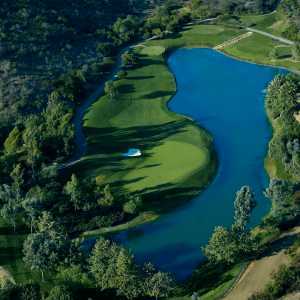"Which sports have you played?" asks Chris, my golf instructor for the next few hours. I hold my hand up against the morning sunshine, adjust my face to an expression of musing and make thinking noises. I’m playing for time. "Knowing that can help adapt your game towards golf," he adds as the pause starts to stretch into an awkward silence. As a lifelong spectator of sports, I am much more comfortable from my sofa throne, where I can hurl helpful advice at elite athletes on my screen like, "Score, you muppet!" But what have I ever done that could be considered athletic? At last, I manage to pull something out of the ether: "Does beer pong count?"
It’s a sunny but chilly day (by San Diego standards) on the Fairmont Grand Del Mar’s golf course, and I’m out on my first round of the trip. I should mention that it’s also the first round of golf I’ve ever played — unless you count that time I caddied for my dad when I was 12 (and, given my measly stipend, I do not). Despite the butterflies in my tummy that tend to flutter whenever I’m about to try something new (and potentially embarrassing), it’s easy to see the appeal as I gaze over the canyons and elevations of The Grand Golf Club.
When I was invited to go on this trip, I was assured that beginners were welcome. I worried my hosts were being kind, but after digging into the statistics on golf, it’s obvious I’m not alone. According to The National Golf Foundation, "the last two years have seen more golfing beginners in the U.S. than when Tiger Woods was at his most dominant" in the late 1990s.
Closer to home, the same patterns can be seen, with Golf Canada and the National Golf Course Owners Association of Canada reporting that people played golf in Canada in 2020 in record numbers. For a sport often dismissed as too expensive and challenging to get into, those figures gave me pause. Was it possible that I might finally find my calling?

As it turns out, my ability to throw a ping pong ball into a Solo cup does have a bearing on my approach to the game. It tends to mean that my short game is better than my long game. Translation: My hand-eye coordination makes it easier for me to get the small white ball into the hole from the fairway (the green part next to the flag) than it is to wallop it from a great distance. I learn this and more at the practice facility, where I’m also fitted for the right TaylorMade putter. Everything from my stance to the way I grip my club affects the kind of player I’ll be, and it’s all under scrutiny on my first few hits.
"Woopsy!" I giggle nervously, after failing to connect the club to the ball on my first few attempts. I’m inexplicably cosplaying as Hugh Grant in Notting Hill, bumbling, fumbling and apologizing my way through each swing. Gradually, things begin to click, and I make contact with the ball, getting out some satisfying swooshing sounds as I go. And then we’re off, loaded into our golf carts and headed to the first tee.
To my immense gratitude, the group opts to play "scramble," which keeps things moving by only playing the best ball hit off the tee. As someone who hits the ball at a 90-degree angle into brushy scrubland with alarming regularity, I think this is an excellent idea, since there’s no waiting around while I retrieve lost balls or chip them endlessly out of a bunker.
I’m heartened to see yet another similarity to beer pong — beer. After a couple of holes, we’re greeted by the drinks cart, offering everything from San Diego craft beer to bloody mary cocktails. Loosened up with the help of some Dutch courage, I have a breakthrough on the sixth hole. Shoulders relaxed, practice swing be damned, I saunter to the tee. I strike the ball clean and hard, without scuffing the grass this time, and before I’ve even started to follow through with my swing, I can tell it’s good. The thwack is pure poetry, and I watch in disbelief as the ball shoots out, straight as an arrow. There’s a breathless pause as the group’s eyes collectively follow its trajectory above the trees, arching gloriously before landing on the edge of the fairway. It’s the best ball of the bunch, notwithstanding those hit by the seasoned players among us.
Whoops of elation ring out across the Los Peñasquitos Canyon in response to my minor victory, but they’re not my own. It’s the cheers from our gaggle of players and caddies that reverberate while I celebrate with a happy dance. It’s a positive atmosphere to learn in, and I wonder if it’s always this way on the golf course. Something tells me it’s the presence of a caddy — in particular, my gregarious co-pilot Judd — bringing a special joie de vivre to this Tuesday morning in December.
Due to the nature of the Fairmont Grand Del Mar’s rolling greens, the resort requires non-members to play with a caddy. But given the ball of optimism that is Judd, I’m convinced I’d never want to play without him. My glory is short-lived. After yet another SNL-worthy slapstick swing-and-a-miss, followed up with a wild slice into the abyss, my caddy brushes it off nonchalantly, as if it happens to Rory McIlroy all the time. "That was my fault," Judd says with a twinkle in his eye. "I should have given you the driver."
And if the world’s best need a partner in crime, why shouldn’t I? At breakfast one morning, we meet Austin Kaiser, the man on the bag for top 10 player Xander Schauffele. Since becoming a PGA Tour caddy five years ago, Kaiser has led Schauffele to several wins, including gold at the Tokyo 2020 Olympics.
Despite his own skill on the course (the pair met golfing at the same college), Kaiser isn’t there to play any PGA holes. Instead, he walks each course beforehand to scope it out, spending about 45 minutes on each hole, taking notes, measuring angles and making diagrams. Yet, for all the science of the game, Kaiser believes his biggest contribution is just saying the right thing at the right time. "You’re a sports psychologist out there at points," he says.

Despite several other groups teeing off around the same time, it feels like we’re the only ones being tickled by the Pacific breeze out here. It’s quiet; it’s serene, and even though newbies like me take their time to practice before every drive, chip and putt, we’re never interrupted by others waiting to start the hole. This is not an accident.
Golf course architect Tom Fazio has created a dramatic landscape for golfers, with a topography that makes each hole feel like it’s in a bubble. Every twist and turn of the golf cart seems to give way to another unreal vista, like a screensaver constantly refreshing. In its most recent makeover, bunkers were tweaked, a 19th hole was added, and tees were introduced for beginners and short hitters who want to play a shorter hole.
I’ve always marvelled at people’s willingness to wake up before the sun to tee off. But as I stand in the stillness of my thoughts, I realize that golf is probably a form of therapy for many. During the pandemic, golf was one of the few activities that allowed for socially distanced exercise — and, for a long time, one of the only ones that Ontarians could engage in. I can only imagine how good it must have felt in the summer of 2020 to stretch one’s legs and give those golf balls hell over 18 holes, releasing months of pent-up energy.
Of course, with unpredictable gradients, plus bunkers and ponds popping out of nowhere, there are also a million and one ways to feel frustrated. I glance at my instructor, who is doing everything in his power to censor himself after yet another disappointing swing. Judd and I exchange a glance. "Golf is a four-letter word," he shrugs.
It occurs to me that there are thousands of golf courses around the globe, all with different terrains, weather conditions and challenges of their own. We’re not just talking about a sweltering day on the tennis court at Flushing Meadows, or a rowdy Boston Celtics crowd baying for blood. Golf courses are battlefields that can turn PGA veterans into uncoordinated toddlers at a moment’s notice, rendering top-of-the-line equipment into useless lengths of steel.
After a nightmare round on the fiendishly difficult Carnoustie Golf Links course in Dundee, Scotland, Sergio Garcia infamously scored 18 over par at the 1999 Open Championship and sobbed on his mom’s shoulder. They don’t call it a handicap for nothing. All things considered, I deem my first round of golf a semi-success.
Pleasantly surprised, mildly frustrated and a bit achy, I head back to my room and flop on my bed. Trying something new was fun, but I’m ready to hang up my clubs for the rest of the trip. Luckily, at the Fairmont Grand Del Mar, there’s more than one way to fill your days. For more exercise and throbbing in muscles you didn’t know you had, guests can saddle up and explore the 400 acres of ridges and ravines on horseback.
Addison, an on-site spot for Southern Californian cuisine, recently became San Diego’s first restaurant to receive three Michelin stars. The Grand Del Mar is also home to a Forbes Five-Star spa, where you can alleviate discomfort after 18 holes with everything from reflexology to lymphatic drainage. Spoiled for choice, I decide that a night of Netflix and sprawling in my California King is all I need for a hole-in-one evening.
